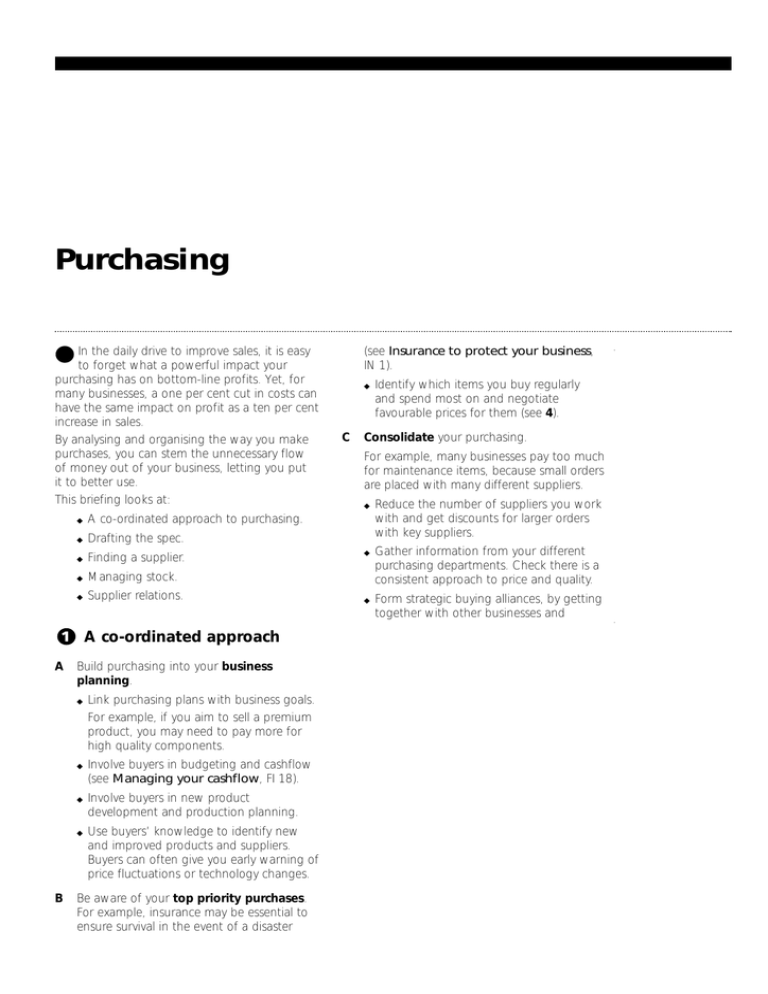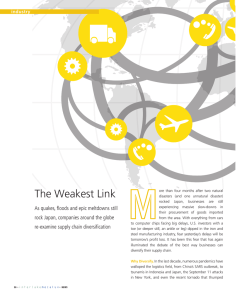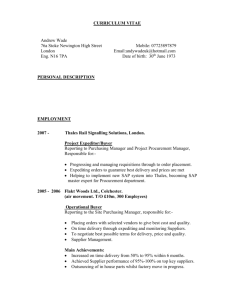Purchasing
advertisement

Purchasing In the daily drive to improve sales, it is easy to forget what a powerful impact your purchasing has on bottom-line profits. Yet, for many businesses, a one per cent cut in costs can have the same impact on profit as a ten per cent increase in sales. By analysing and organising the way you make purchases, you can stem the unnecessary flow of money out of your business, letting you put it to better use. This briefing looks at: ◆ A co-ordinated approach to purchasing. ◆ Drafting the spec. ◆ Finding a supplier. ◆ Managing stock. ◆ Supplier relations. A co-ordinated approach A Build purchasing into your business planning. B ◆ Link purchasing plans with business goals. For example, if you aim to sell a premium product, you may need to pay more for high quality components. ◆ Involve buyers in budgeting and cashflow (see Managing your cashflow, FI 18). ◆ Involve buyers in new product development and production planning. ◆ Use buyers’ knowledge to identify new and improved products and suppliers. Buyers can often give you early warning of price fluctuations or technology changes. Be aware of your top priority purchases. For example, insurance may be essential to ensure survival in the event of a disaster (see Insurance to protect your business, IN 1). ◆ C Identify which items you buy regularly and spend most on and negotiate favourable prices for them (see 4). Consolidate your purchasing. For example, many businesses pay too much for maintenance items, because small orders are placed with many different suppliers. ◆ Reduce the number of suppliers you work with and get discounts for larger orders with key suppliers. ◆ Gather information from your different purchasing departments. Check there is a consistent approach to price and quality. ◆ Form strategic buying alliances, by getting together with other businesses and pooling your resources. F D Manage your costs (see Cost control, ST 2). ◆ Plan in advance for major purchases. ◆ Avoid fixed costs, except when you are sure they will work to your advantage. For example, think carefully before committing yourself to long-term fixed rate financing, or raw materials bought under agreed fixed price contracts. ◆ E Consider alternatives to purchasing (see box). When considering finance deals, discuss the tax implications with your accountant (see Financing equipment, FI 7, and Overdrafts and bank loans, FI 1). ◆ If you are a manufacturer, consider using standard components, to reduce design and manufacturing costs. ◆ Consider using a purchasing consultant to analyse and reduce your spending. Drafting the spec A Ask the users to help you define exactly what you need. B Avoid over-dependence on one supplier. Have a contingency supplier in reserve. ◆ Get the benefits of working in partnership with key suppliers (see 6). ◆ Consider using a specialist agent. For example, get a print broker to help you save money on your printing bills. You can use agents when buying in services, too. For example, temporary staff or computer maintenance. Purchasing alternatives C For example, cleaning, maintenance, security and computer services. B C Benefits may include low costs, flexibility and up-to-date technical know-how. ◆ Make sure the contractor can guarantee the quality and timescales you need. Secondhand equipment may be perfectly adequate and cost much less. ◆ Check that the seller is the legal owner. ◆ Find out what recourse you have in the event of a breakdown. Get a guarantee. Get your employees to suggest cost-saving opportunities and give them incentives to do so. ◆ Use customer feedback records to tell you what is good and what needs improving. ◆ Ask your suppliers to suggest improved products and services. List the important features of the item you are buying. For example, size, quality, technical features or delivery schedules. Other factors may rule suppliers or individual products in or out. ◆ Compatibility with existing systems may be a deciding factor. For example, buying the new release of your existing software may reduce training and maintenance costs. ◆ For long-term supplies, choose a reliable supplier that is unlikely to go out of business. ◆ A guarantee is only significant if the supplier will honour it. ◆ Technical skills or training may be needed. You may have to take on specialist staff. ◆ Expansion options may be important. E ◆ Assume everything that can go wrong will. You need to know how quickly help will arrive and how much it will cost. ◆ Find out if spare parts will be available and how experienced the support staff will be. For major purchases, put together realistic lifecycle costings. For example, when buying computers, the main costs lie in running and learning how to use the system (see Specifying and purchasing IT, IT 6). ◆ Consider leasing for acquisitions such as cars and photocopiers. But be aware that there can be pitfalls. ◆ Check the small print. For example, must you give notice at the end of the lease and continue paying for three months? List critical factors in order of importance. D Good technical support may be essential. A Outsourcing services may be more costeffective than using permanent staff. ◆ ◆ ◆ Make purchasing relationships work for you. ◆ It is essential to review your purchasing performance (see 7). Other lifetime costs include installation, consumables and maintenance. Finding suppliers A Get recommendations from friends and business contacts you trust. ◆ Ask your local business support page 2 organisation for a list of suppliers in your area, or contact your trade association. B C ◆ Meet potential suppliers at exhibitions. ◆ Use business directory websites, such as www.yell.com, www.scoot.co.uk, www.kompass.com and www.uktradeinvest.gov.uk. Negotiating a purchase A Plan ahead for the negotiations. ◆ Set out objectives and what is negotiable. ◆ Analyse the strengths and weaknesses of both sides’ negotiating positions. ◆ Anticipate the supplier’s negotiating tactics and prepare your response. ◆ Get a deal that works for you and keeps the seller happy. Do not squeeze suppliers too hard if you are planning to buy from them in the future (see 6). Get quotes. ◆ With your request for a quote, send each supplier a standard checklist covering all your requirements. ◆ Get suppliers to quote a guaranteed price and state how long it will be valid. ◆ Ask what discounts you would get if you entered into a long-term supply contract. ◆ When delegating purchasing to a colleague, provide at least an informal outline of what you want. For example, ‘I want a name brand printer of the sort usually used by businesses like mine.’ B ◆ C Compare suppliers in terms of the factors that matter most to you. These may include: ◆ Product suitability and reliability. ◆ Speed and frequency of delivery. ◆ Quality and flexibility of service. ◆ Price range and order size. ◆ Location and ease of communication. ◆ Reputation — ask for evidence of similar work and follow up references. ◆ Financial position. Check whether the supplier has quality assurance systems and, if appropriate, get a copy of the certificate of ISO 9000 accreditation. Simple savings Get agreement on your priority issues — for example, availability, quality and payment terms — and get the details in writing. For example, tell the supplier how you intend to use the product and get written confirmation that the product is suitable. Agree with the supplier what sort of contract you will use. Verbal contracts are legally binding but difficult to prove in court. ◆ Your written contract may refer to your own or the supplier's terms of trade, as well as details from your original spec. ◆ Beware of long maintenance contracts. Read the small print and ask the supplier to spell out your future commitments. ◆ For important contracts, consider getting legal advice. D Agree what will happen if problems arise. For example, if goods are faulty, will the replacement be authorised immediately? Who will pay for delivery? ◆ Agree delivery performance standards as a condition of your contract. ◆ Set penalties for contract infringements, such as missing critical delivery dates. See Negotiating a purchase, PU 1. A Save on cars (see Car finance, FI 6). B ◆ If your company has a substantial fleet, you can negotiate large discounts. ◆ Buy ‘nearly new' vehicles with few miles on the clock. A Order at the right time. ◆ Monitor your stock turnover. Identify seasonal peaks and prepare forecasts. ◆ Plan when to re-order regular supplies. ◆ Avoid surprises. Develop a clear reporting system, so you can find out what is needed, when, from your employees. Consider alternative telecoms suppliers. ◆ C Managing stock Review old bills and identify your call profile. Choose a supplier that offers the service and admin back-up you need. Do not overpay for utilities. ◆ Review your utilities contracts regularly. ◆ Though it may be convenient, it is usually more expensive to get your gas and electricity from the same supplier. B Introduce systematic ordering. ◆ Set budget limits and make it clear who can authorise purchases. ◆ To reduce administration, give individual page 3 managers purchasing limits, rather than centralising all purchasing. ◆ C Copy ordering information to the person placing the order, accounts people and goods inwards staff, as well as suppliers. ◆ Get suppliers and employees to fit in with your ordering systems and quote your order reference codes. ◆ Put one person in charge of petty cash, to cover small, one-off items. C Decide how you want to store your stock. ◆ Balance the advantages of discounted bulk orders with the benefits and risks of justin-time ordering. ◆ Investigate the possibility of getting your supplier to hold stocks for you. ◆ Keep them up to date with your needs. ◆ Inform suppliers of the time constraints affecting your business. ◆ Tell them when they are doing well and when improvements are needed (see 7A). ◆ Invite them to meetings. Ask them for their views and ideas. Make the most of a good working relationship. ◆ Get longer payment terms and bulk or cumulative discounts. ◆ Agree long-term supplier contracts or guarantee minimum annual purchase volumes, in return for lower prices. ◆ Co-operate to improve your goods and services and develop relevant systems and procedures together. D Avoid problems on delivery. ◆ Set up a reminder system for late goods. ◆ Note when goods arrive and store them in a known place. ◆ E Make sure delivery notes are not signed until deliveries have been checked. If you must sign, note any reservations (eg ‘goods not checked’) and tell the seller. ◆ Make sure all relevant people are told when goods arrive. ◆ Ask for money off for minor faults at goods inwards inspections. Discuss recurring quality problems with the supplier. ◆ D Even in a long-term business relationship, make sure you keep the upper hand. Check invoices to avoid incorrect charges, double billing and missing discounts. ◆ You can sometimes find bargains in online auctions. For example, for obsolete stock and secondhand machine tools, try www.goindustry.com. Supplier relations B B Visit the supplier's offices or factory and get to know the people you deal with. Tell key suppliers what they need to know. Get regular suppliers to tell you how often prices will go up, what will cause them to rise and how you will be notified. ◆ Underpin key relationships with contracts. ◆ Check how suppliers perform (see 7A). ◆ Quality — get improvements in areas that affect the quality of your own product. ◆ Price — compare suppliers with their competitors and get them to explain their pricing policies. ◆ Delivery — including speed and reliability. ◆ Communication — including speed of response to your letters. Off-the-shelf vendor rating systems can help you assess a supplier’s performance. A Build relationships that both sides value. For example, if your business represents more than, say, five per cent of a supplier’s work, you are probably entitled to special treatment. ◆ ◆ A Track suppliers’ performance on a regular basis. List your key priorities and give each supplier a rating out of 20 in each area. Group buying sites may provide opportunities to keep costs down. Your key suppliers are those you spend most with and those supplying vital goods or services. Always know what your suppliers' competitors have to offer. Reviewing performance Find out if e-procurement can help you. ◆ ◆ C Review your own purchasing performance. ◆ Use a spreadsheet or cost control package to help you record and compare your purchasing costs on a regular basis (see Using accounting software, IT 3). ◆ Send suppliers a form that invites them to rate you on issues that are important to them, eg prompt payment. Set realistic improvement priorities, rather than trying to improve everything at once. page 4




